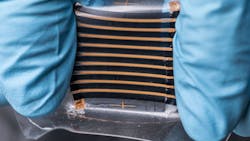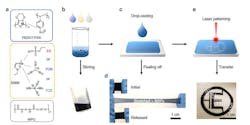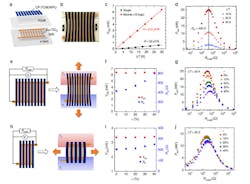Composite Thermoelectric Generator Material Easily Flexes and Stretches
Thermoelectric generators (TEGs) and TE modules are attractive potential sources of harvested energy, but the stiffness of available module materials makes them awkward and unsortable for “personal” on-skin use, despite the availability of the heat source (skin). To counter this limitation, a university-based team has created what they claim is the first intrinsically stretchable, organic, thermoelectric module that’s soft and stretchable, making it a good fit for wearable applications such as skin patches.
The multidisciplinary team was led by researchers at the Laboratory of Organic Electronics at Linköping University (Sweden), with support from researchers in Belgium, New Zealand, and California. They combined three materials: the conducting polymer PEDOT:PSS (a very common polymer used in many applications due to its good thermoelectric properties, but too hard and brittle for wearable electronics); a water-soluble polyurethane rubber; and an ionic liquid.
The result is a composite with unique properties, with material bringing desirable characteristics to the composite. The PEDOT:PSS gives it thermoelectric properties, the rubber provides elasticity, and the ionic liquid ensures softness.
However, combining them, while not adversely affecting their desirable properties, was a major challenge (Fig. 1). “Our material is 100 times softer and 100 times more stretchable than PEDOT:PSS,” said Klas Tybrandt, who leads the group of Soft Electronics at the Laboratory of Organic Electronics.
1. Printable elastic conducting polymer composites: Chemical structures (a) of PEDOT:PSS (conducting polymer (CP), water-borne polyurethane (WPU), and different types of ionic liquids (ILs), of which aqueous dispersions/solution can be mixed in one pot to formulate the composite ink (b). The solution processability of the composite ink (c) allows for drop-casting to produce thick films (>40 µm). A free-standing composite film can be stretched to over 600% and relax to its original shape with little hysteresis (d). A laser-patterned composite film can be transferred and adhere to irregular surfaces like textiles (e). (Source: Linköping University/Sweden)
Added project leader Nara Kim, ”The composite was formulated by water-based solution blending and it can be printed onto various surfaces. When the surface flexes or folds, the composite follows the motion. And the process to manufacture the composite is cheap and environmentally friendly.” The resultant material has superior performance in the three top-tier areas of interest as it combines high conductivity (>140 S/cm) with superior stretchability (>600%), elasticity, and low Young’s modulus (<7 MPa).
As a TE material, electrical performance is an important consideration, of course (Fig. 2). A module was fabricated by laser-cutting the drop-cast composite film into 10 legs of uniform thickness and transferring them onto a substrate. The legs were then connected in series by a pattern of gold-coated titanium-dioxide nanowires embedded in the substrate.
2. Intrinsically stretchable organic thermoelectric module: (a) An architecture of the stretchable thermoelectric (TE) module. One end of each TE leg is electrically interconnected with the other end of a neighboring leg through a z-shape stretchable interconnect. (b) Photograph of a stretchable TE module under 30% tensile strain. (c) Open-circuit voltage (VOC) of a single-leg TE device and a 10-leg TE module as a function of temperature difference (ΔT). d) Output power (Pout = Vout2/Rload) of a TE module as a function of load resistance (Rload) for ΔT = 10-30 K. The dashed line indicates a Rload value that gives the maximum Pout, and thereby corresponds to the total internal resistance (Rin) of a module. (e-g) TE module stretched parallel with the thermodiffusion; T1 = 23 °C, T2 = 53 °C; f) VOC; and Rin vs. tensile strain (ε) applied to a module for ΔT = 30 K. (g) Pout vs. Rload under different strains for ΔT = 30 K. (h-j) TE module stretched perpendicular to the thermodiffusion and corresponding VOC and Rin vs. ε and Pout vs. Rload under different strains for ΔT = 30 K. (Source: Linköping University/Sweden)
Among the measured results, with a temperature difference (ΔT) of up to 30 K applied to the two edges of the p-type 10-legs module, the open-circuit voltage (VOC) generated is linearly proportional to ΔT, resulting in a VOC/ΔT ≈ 212 μV/K—this is close to 10 times the Seebeck coefficient of S ≈ 22 μV/K measured for a single TE leg.
When the module is connected to varying load resistors (Rload) under ΔT = 10 to 30 K, the Pout reaches its maximum for Rload ≈ 430 Ω, which corresponds to the total Rin of the module. The maximum Pout under ΔT = 30 K is 25 nW, which is close to the predicted value, Pout-max = VOC2/4Rin ≈ 24 nW. Tensile loading up to 40% in both parallel and perpendicular directions didn’t affect the VOC of the stretchable module. However, the Rin increases gradually with increasing strain due to the strain-dependent resistances of the composite legs and the interconnects.
Details of the project are published in Nature Communications, “Elastic conducting polymer composites in thermoelectric modules,” along with considerable additional details in the posted Supplementary Information.


